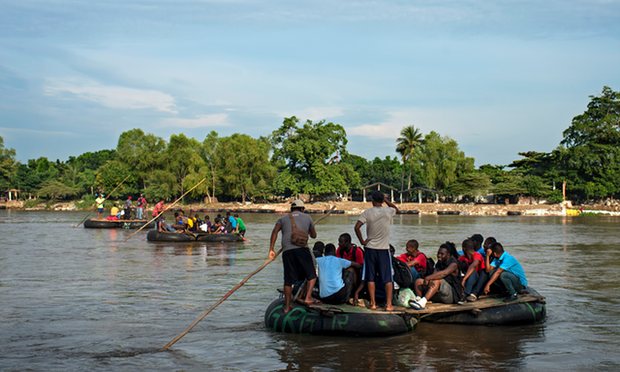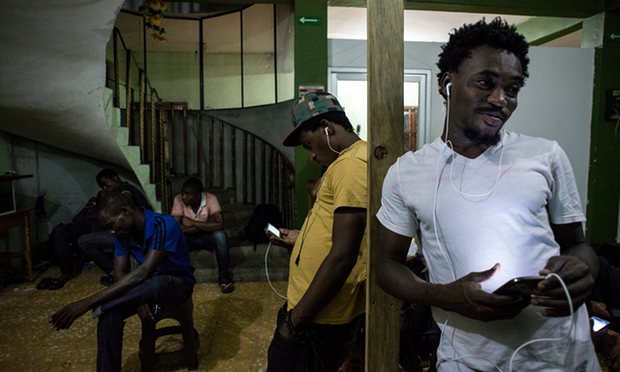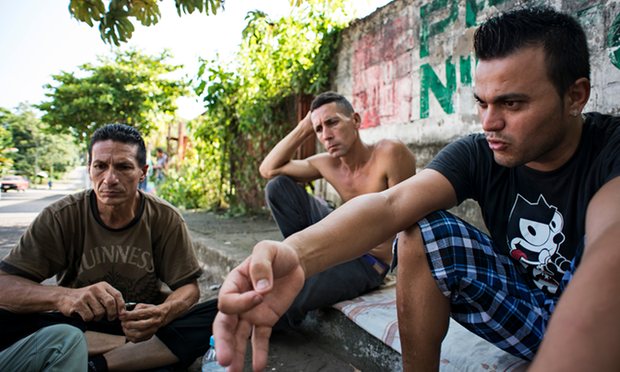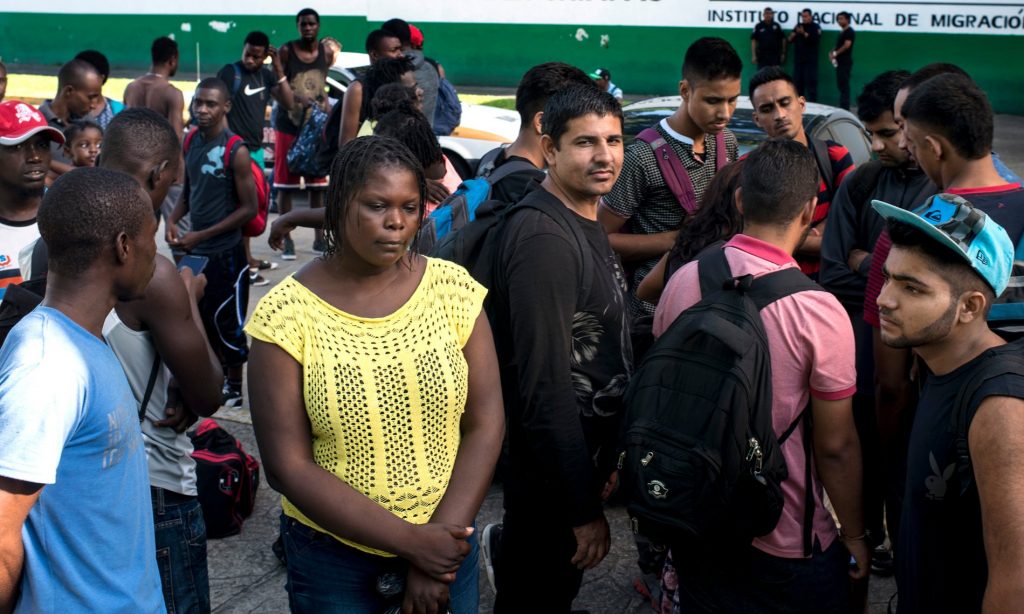The sun has barely risen and already hundreds of migrants are gathered outside the vast white and green immigration detention centre, hoping to get through its gates.
Most have travelled thousands of miles on foot, by boat and bus from South America, but few here speak Spanish. In front of the locked gates near Mexico’s southern border, it’s an eclectic mix of French, English, Creole, Urdu, Lingala and Somali.
This eclectic crowd is part of a huge surge in African and Asian migrants traversing the Americas in hope of a better life in the US. The circuitous passage means paying thousands of dollars to coyotes – or people smugglers – to cross 10 countries, where overcrowded fishing boats, mosquito-infested jungles, armed bandits and immigration agents await.

Photograph: Encarni Pindado for the Guardian
Despite the dangers, about 7,882 Africans and Asians presented themselves at Mexican immigration in the first seven months of this year – 86% higher than in the whole of 2015 and more than four times the number registered in 2014. At the end of August, Tapachula’s immigration registered 424 Africans in just two days.
Over the past decade, Latin America has become an increasingly popular route of entry to the US for Asian and African migrants, but the current surge in numbers is unprecedented.
The numbers are still tiny compared to the hundreds of thousands of Central Americans fleeing violence and poverty, but the treacherous route crossing Latin America is becoming increasingly popular as people from across the world seek new ways to reach the US.
The vast majority arrive in the city of Tapachula near the Guatemalan border, without a visa or even a passport. But unlike Central Americans, these migrants can obtain a temporary travel document which allows them to continue unimpeded to the US border since Mexico has no deportation agreements with their countries.
‘We saw a dead man without head or hands’
By 8am, it’s already fiercely hot outside the immigration center and there are too few shady trees for the growing crowd. To kill time, people listen to music on their phones or discuss the best ways to travel north. Those with money will fly to the Mexican cities of Tijuana, Matamoros or Mexicali, others will risk several days on buses through states plagued by organised crime, where Central American migrants are routinely targeted by traffickers and kidnappers.
Habte Michael, 28, from Asmara, Eritrea, just arrived – three months after setting off from São Paulo, Brazil. After a punishing journey he’s exhausted, but optimistic he’ll soon be in America where he will seek refuge.
Michael left Uganda for Rio Branco in northern Brazil in September 2015. He spent a few months learning Portuguese and planning his route, before crossing into Peru in May 2016. Next, he travelled overland on buses with the help of “connectors” – an organised network of individuals who help migrants buy bus tickets and find cheap hotels – through Ecuador and Colombia. In Turbo on Colombia’s west coast, he took a boat to Panama where he walked with Africans, Bangladeshis and Haitians for five exhausting days through acres of mountainous jungle with a coyote.

In June, after walking for three days, his group found the washed-up body of a west African man. “The river took him as he was walking in a group without a coyote, so he didn’t know where it was safe to cross. In Panama we saw another dead man, also black, without head or hands.”
Advertisement
Entering Costa Rica is fine, but leaving ithas been much tougher since Nicaragua decided to close its border last year to stop the flow of Cubans migrating to the US. There are about 2,000 migrants from across the world currently trapped in dire conditions on the border with Nicaragua, at a camp in Peñas Blancas. In August, 10 migrants – mostly Haitians – drowned crossing Lake Nicaragua.
Michael was caught three times by Nicaraguan immigration agents and sent back to the camp. Like at least two dozen other migrants interviewed by the Guardian, he was robbed at gunpoint while walking through the Nicaraguan jungle. Desperate, he paid $1,000 to a truck driver to take him to Honduras, but the driver never showed up.
“Each time a coyote takes your money or you get robbed, you must wait for family to send you something to carry on,” Michael said. “It’s the only way – I can’t go back.”
Michael eventually made it to Honduras – six weeks after arriving at the Costa Rica-Nicaragua border. Many migrants described Honduras as the easiest country to cross, as irregular migrants – those not from Central America – are given travel permits.
Each time a coyote take your money or you get robbed, you must wait from family to send you something to carry on
Habte Michael, migrant from Eritrea
In contrast, Panama and Nicaragua are the most dangerous.
Abdua Kareema, 38, from Ghana, was robbed by four gunmen in the jungle near Managua.
“They stripped the women and searched them intimately to see if they were hiding anything,” Kareema said. “One woman had her time of the month, but the robber thought the feminine pad was something hidden, so he slapped her face.”
Similar reports of sexual violence against women are common.
‘We just looked up a route on Google’
Advertisement
By mid-morning, immigration officers have let through about 200 people who will spend a few days or weeks locked in, while their travel permits – which give them 21 days to leave Mexico – are processed. Most are economic migrants and will be given safe passage by Mexico. Meanwhile, busloads of detained Central Americans enter the gates; with most deported home the next day, to face the violence and threats they fled.
The rest, including Michael, are given dates to return later in the week. Disappointed, they sit around eating lychees and cheap biscuits, deciding what to do next.
But still, more people arrive. About 15 young men from the Punjab region of India arrive with their rucksacks, straight from the Guatemalan border which they had crossed by raft.
Some flew from Delhi to Ecuador via Istanbul, others came via Indonesia and Dubai.

“We didn’t pay guides, we just looked up the route on Google,” said Herdeep Ghotra, 26, a truck engineer. “Also my cousin came the same way two years before.”
Ghotra walked six days through the Panama jungle where he saw seven dead migrants – six men and one woman, all black. It’s not clearly how or when they died, or if their bodies have since been recovered. Ghotra was also robbed at gunpoint in Nicaragua: “They took $200 and my love, my HTC phone.”
The Indians talk mostly about wanting to make a better a life for themselves. Some are trying to reunite with family members in the US, while Ghotra says a violent family conflict forced him to leave.
An immigration officer emerges to tell them to come back in two days and prepare to be inside the center for a week. After that, they’ll wait for money to be wired by relatives to fly to Tijuana where thousands of Africans, Asians and Haitians have descended this year.
No one here seems to be aware that US border control agents are now working here amid growing American concerns about security risks following recent terrorist attacks in the west.
‘I welcome them with love’
Tapachula’s main square is jam-packed with people enjoying noisy fair rides and junk food stalls.
On an avenue just off the main square, lie the cheap hotels where most African and Asian migrants choose to stay; where a new curry house – run by a Mexican cook who was taught to make dhal and fish curry by a Bangladeshi migrant – is the most popular food joint.
Just off the main drag is Mama Africa’s – what everyone calls Concepción González, 56, who runs the $3a-night, no-frills Imperial Hotel. Here, there are people from across Africa: Burundi, South Africa, Nigeria, Somalia, Mozambique, Ghana, Congo and many Haitians pretending to be Congolese in order to avoid deportation.

“They tell me how they want to make a better life for their families, I can understand and welcome them with love,” González told the Guardian.
There are 70 beds squeezed into 15 rooms, but tonight it’s packed, so there are couples and mothers with infants resting on wafer-thin mattresses in the internal patio.
Fedolina, 39, from Angola, has a ghostly look of pain and fatigue marked across her face. She fell while running from armed robbers in Nicaragua two weeks ago. Her right arm hangs limp, her shoulder looks dislocated, and there’s a nasty gash on her forehead. She has yet to see a doctor.
González moves her into a quiet room and promises to take her to hospital in the morning.
As the plight of Syrians fleeing war continues to yield untold horrors in Europe, in this region, emerging crises also provoke new routes and new dangers.
Last year, Mama Africa was Mama Cuba as almost 10,000 Cubans entered Mexico amid rumours that the US visa waiver programme could end with the thawing of diplomatic ties. The numbers have plunged amid tighter travel restrictions in Latin America, but those determined to leave Cuba have found new routes.
Pig farmers Ernesto Pérez, 46 and Onel Martín, 44, left their hometown Manzanillo on the Caribbean coast last July on a handmade boat. Powered by a car engine, they sailed with 25 others, including nurses, a mechanic, and an economist. It took seven days and 1,000km to reach the Honduran Bay Island of Guanaja Bay, a risky but increasingly common route used by Cubans.
“Our reason for leaving is purely economic, increased tourism has made no difference to our lives. I sold my few valuable things, my pigs, television and fan, to make this journey. But now what?” said Martin, contemplating his next move outside the Belén migrant hostel.
After a temporary reprieve, immigration raids in Mexico are once again targeting Cubans.

In a surprise visit to Mexico earlier this week, Republican candidate Donald Trump reiterated his intent to build a wall along the US-Mexican border in order to end all migration from the Americas.
But wall or no wall, desperate people do desperate things.
In Tapachula airport Lejma, 21 and husband Ahmed, 22, from Mogadishu, Somalia, comfort their hysterical little girl, who thinks the immigration officers in white uniforms are doctors.
“She was very sick in the boats and got bitten by many mosquitoes when we walked seven days in the jungle,” said Ahmed. “She was then in hospital in Costa Rica for nearly one week and had many injections.”
Somaya, just 22 months, is covered in bite scars.
The family left Somalia to escape a police officer who was harassing Lejma, a waitress, demanding she be his wife. When she refused, the family was threatened by the officer’s colleagues and clan.
Their plan is to fly to Matamoros, Tamaulipas, and then claim asylum at the Brownsville border crossing in Texas.
“There is no justice in my country, we had to leave,” Ahmed said. “I hope we can work and one day bring our families to America.”

